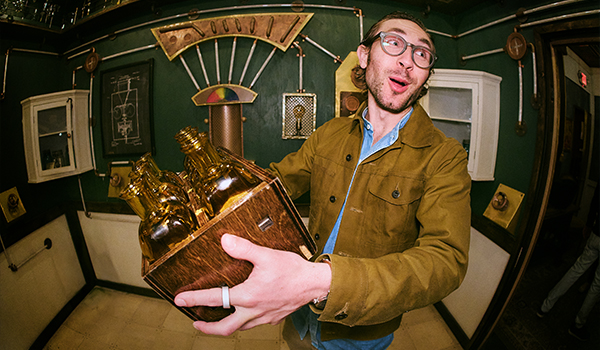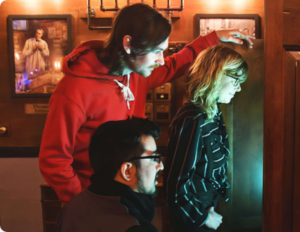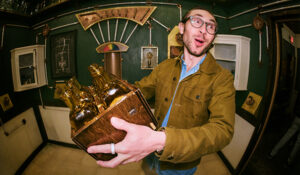Beyond the Lock: Deconstructing the Story-Driven Escape Room
What separates a simple puzzle challenge from a truly immersive adventure? While any escape room can offer a series of clever brain teasers, the most memorable experiences transport you to another world, making you the protagonist in a story you live, not just observe. This distinction lies in two fundamental design philosophies: ‘puzzle-first’ versus ‘story-driven’. A puzzle-first room challenges you to escape; a story-driven room invites you to become part of a narrative. This article deconstructs the core elements of a story-driven experience, exploring how narrative, technology, and environmental design combine to create a more profound and impactful adventure.
The Evolution of Escape Rooms: From Generation 1 to 3
The escape room industry has evolved rapidly, with experiences often categorized into three distinct generations. Understanding this progression helps clarify what makes modern, story-driven rooms so different from their predecessors.
Generation 1: The Puzzle-First Foundation
Generation 1 (Gen 1) rooms are the classic foundation of the industry. As described by industry experts, these experiences are characterized by a primary focus on puzzles over plot. The theme is often a light suggestion—a ‘mad scientist’s lab’ or a ‘prison cell’—that serves as a backdrop for a series of locks and keys. The gameplay is typically linear, with one puzzle leading directly to the next, and the primary goal is simply to open the final door within the time limit. Technology is minimal, relying on mechanical locks, combination safes, and hidden keys. While fun and challenging, the narrative in a Gen 1 room is secondary to the mechanics of solving puzzles [1].
Generation 2: Integrating Story and Technology
Generation 2 (Gen 2) marks a significant step forward. In these rooms, the narrative becomes more important and begins to integrate with the gameplay. Designers started incorporating technology like magnetic locks, sensors, and basic electronics to create more dynamic and surprising reveals. Instead of just finding a key, players might place an object on a pedestal to unlock a secret compartment. The environment often expands beyond a single room, with hidden passages and new spaces to discover. The story provides context for the puzzles, but the two are not always seamlessly intertwined [2].
Generation 3: Living the Story
Generation 3 (Gen 3) represents the pinnacle of immersive entertainment, where the story is the entire experience. In a Gen 3 room, players are not just solving puzzles; they are active characters within a developing plot. The environment is cinematic, with high-production-value sets, lighting, and sound design that create a believable world. Technology is seamlessly integrated and often invisible, used to trigger narrative events and create moments of magic. Puzzles are no longer standalone challenges but are organic parts of the story, serving as tools to advance the narrative. This is the design philosophy behind the adventures at Palace Games, where the goal is to make you forget you are in a game and instead feel like you are living an adventure.
The Heart of Immersion: Diegetic vs. Non-Diegetic Puzzles
The most critical element separating a story-driven room from a puzzle-first one is the nature of its puzzles. This concept, borrowed from film and game design, is best understood through the terms ‘diegetic’ and ‘non-diegetic’.
Non-Diegetic Puzzles
A non-diegetic element is something that exists outside the world of the story, intended only for the audience or player. In an escape room, a non-diegetic puzzle is one that exists purely for its own sake and is not justified by the story’s logic or environment. For example, finding a Sudoku grid on the wall of a medieval dungeon or a laser maze in a 1920s speakeasy are non-diegetic. These puzzles can be clever, but they momentarily break the illusion by reminding you that you are just playing a game [3].
Diegetic Puzzles
A diegetic puzzle, by contrast, is a natural part of the story’s world. As a design concept, diegetic elements enhance immersion by making interactions feel authentic to the environment [4]. Solving a diegetic puzzle feels like performing a realistic task within that world. For instance, in a spy-themed room, a non-diegetic puzzle might be a random riddle, whereas a diegetic puzzle would involve using a codebook to decipher an intercepted enemy message. The action of solving the puzzle advances the plot and reinforces the player’s role within the narrative. This is the key to making players feel like active participants rather than passive observers.
Pillar 1: Environmental Storytelling
In a story-driven escape room, the set is not just decoration; it is a character that actively tells a story. This technique, known as environmental storytelling, uses the physical space to convey narrative, history, and mood without relying on explicit text or dialogue [5]. Every object, texture, and architectural detail is chosen to build a believable world and immerse the players within it.
The authenticity of the environment is paramount. When a room is built with historical and architectural accuracy, it creates a powerful sense of time and place. For instance, the setting for The Roosevelt Room is not a generic office. It is a meticulously designed 1915-era war room located within San Francisco’s actual Palace of Fine Arts, a building constructed for the 1915 Panama-Pacific International Exposition. This historical alignment between the game’s story and its physical location makes players feel they have truly stepped back in time, blurring the line between game and reality.
Pillar 2: Technology as a Narrative Tool
While Gen 2 rooms introduced technology, Gen 3 rooms master its use as a narrative device. In a premium story-driven experience, technology should be invisible and serve the story, creating moments of ‘magic’ rather than feeling like a tech demo. The goal is not to show off complex wiring or sensors but to make the impossible seem possible within the world of the game. This approach is central to modern immersive theater, where technology enhances the audience’s connection to the performance [6].
This contrasts sharply with early tech use, where solving a puzzle might trigger a simple magnetic lock to open with a clunk. In a story-driven room, advanced technology can trigger dynamic narrative events, respond to player actions, and transform the environment itself. For example, in The Edison Escape Room, technology brings the inventor’s workshop to life. Rather than just unlocking a door, solving a puzzle might cause one of Edison’s actual inventions to whir to life, revealing the next part of the story in a way that feels authentic to his genius and the historical setting.
Why Story-Driven Design Creates Better Team Experiences
A common critique of corporate team-building is that many activities are superficial and fail to create lasting impact [7]. However, story-driven escape rooms overcome this by creating a framework for meaningful collaboration. A shared narrative goal fosters a deeper level of teamwork than simply solving a series of disconnected puzzles.
In a puzzle-first room, team members might work in isolation, focusing on individual challenges. In a story-driven game, the narrative demands communication and collective strategy. Team members must discuss plot developments, share information to understand the bigger picture, and work together to overcome narrative obstacles. This process mirrors the collaborative problem-solving required in a professional environment, where success depends on a shared understanding of a common goal. This makes story-driven rooms particularly effective for corporate team-building, as the focus shifts from individual puzzle-solving prowess to collective success in a shared mission. The adventure provides a memorable context for practicing communication, leadership, and group problem-solving skills, as outlined in our Corporate Off-Site Blueprint.
Choose Your Adventure
Ultimately, the two design philosophies offer fundamentally different experiences. A puzzle-first room tests your ability to solve puzzles. A story-driven room invites you to live inside a story. It challenges you to think like a character, to piece together clues that are woven into the fabric of the world around you, and to become the hero of your own adventure.
The goal of a premium escape experience is not just to challenge the mind, but to create a lasting memory and a sense of genuine accomplishment. It is about the collective gasp when a secret passage is revealed, the thrill of executing a plan, and the satisfaction of seeing a story through to its conclusion. As creators of award-winning, immersive worlds, we believe that the greatest adventures are the ones where you forget you are playing a game at all.



